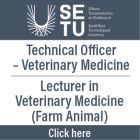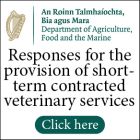Large animal - July 2019
Addressing the drop in milk solids during early lactation at grass
There is much discussion among dairy farmers about low butterfat levels in milk. A decline in butterfat percentages can be common during spring months when cows are grazing lush grass that is low in fibre and high in oil and sugars. However, this issue can continue into the summer for some herds, writes Richard Dudgeon, regional manager, Alltech Ireland
Factors contributing to a decline in butterfat
Butterfat is produced in the mammary gland, approximately 50% from acetate and butyrate and 50% from the dietary intake of fatty acids or the mobilisation of body fat. It is believed that a key factor for the occurrence of milk-fat depression is an elevated intake of unsaturated fatty acids from young, leafy grass, which can be particularly high in linolenic acid. These unsaturated fatty acids are normally biohydrogenated in the rumen into saturated fatty acids (stearic acid) through a series of ‘milk fat-friendly’ chemical alterations in the fats. In certain circumstances, however, the process of biohydrogenation produces ‘milk fat-depressing’ intermediate products, such as trans-10 cis-12 conjugated linoleic acid (CLA). Data has shown that as little as 2g of this CLA from the rumen can reduce milk-fat production by as much as 20%. Some of the conditions known to result in the production of milk fat-depressing intermediates include a high level of unsaturated fatty-acid ingestion, low rumen pH and undefined states of an altered rumen environment. International data has shown that, with a low rumen pH, a much greater amount of milk fat-depressing intermediates is produced from a given level of unsaturated fatty acids. This link between rumen pH and milk-fat depression is important. In Ireland and Australia, it has been demonstrated that herds of cows with acidosis or sub-acute ruminal acidosis (SARA) have lower milk-fat percentages.
Low rumen pH may also result in other significant consequences for the cow, such as reduced fibre digestion. Some research suggests that rumen acidosis can impact the cow’s ability to maintain an effective rumen lining and can potentially cause lameness (laminitis).
Research conducted in Ireland through University College Dublin (UCD) Lyons Farm has illustrated that a specific live yeast strain Saccharomyces cerevisiae strain 1026, can help increase rumen pH and reduce the duration of periods of low rumen pH during the day. Furthermore, cows fed this specific live yeast strain had significantly less body fat mobilisation – non-esterified fatty acids – and showed a statistical tendency toward better energy balance.
Improving butterfat levels
There are many steps farmers can take to try to improve butterfat levels. If you are not happy with your milk-fat percentage, try strip grazing, as this will force the cow to eat the leaf and stem, and the leaf is high in oil and low in fibre. Try not to graze very low covers, even though this is sometimes difficult to avoid. When choosing a supplement, look for feeds high in digestible fibre, such as soya hulls and beet pulp, and avoid wheat that is rapidly digested. Look at your herd genetics – how does your herd compare to other herds, in terms of fat percentage PTA?
Live yeast? Says who?
Avoiding conditions that can lead to low rumen pH and SARA is crucial to ensure that the rumen is working at its best; the bacteria in the rumen will be working more efficiently, optimising the breakdown of fibre from grass or silage and concentrates. Live yeasts have been used quite successfully to achieve these prime conditions, but while many yeasts claim to have a positive impact, only one is supported by published and proven research in Ireland. In fact, studies of S cerevisiae strain 1026 constitute almost 50% of the total research on all yeast products worldwide. It is also the only live yeast that has been shown to have a positive impact on dairy cow nutritional status (ie. improved rumen pH, less fat mobilisation, better energy balance) at Irish research centres, such as UCD.
The live yeast, S cerevisiae strain 1026, which is an active strain of live yeast with a specific impact on rumen activity, was developed as the result of more than 100 controlled animal research trials. It works by metabolising excess oxygen and increasing the amount of lactic acid-utilising bacteria, which help remove acid and increase the rumen pH.
Trials studying S cerevisiae strain 1026 conducted at UCD Lyons Farm highlighted its ability to significantly increase the rumen pH of cows throughout the day, compared to cows who did not receive live yeast (Figure 1). The data below was taken 22-24 days after calving; at this stage, 50% of the cows were grazing full-time (plus 3.5kg of feed), and the remaining 50% were grazing by day. The basal diet did not impact the effectiveness of the live yeast.
As these results illustrate, adding the specific live yeast, S cerevisiae strain 1026, to your feed can help maintain higher rumen pH levels and help prevent SARA.
Role of saccharomyces cerevisiae strain 1026 and VFA production
Carbohydrates from the diet are fermented into volatile fatty acids (VFAs) in the rumen. These end products of digestion provide the dairy cow with much-needed metabolic fuel for her energy requirements. In the study mentioned above, UCD demonstrated that cows fed this specific live yeast had significantly higher levels of VFAs. Cows fed live yeast strain 1026 were able to produce more energy from their feed, decreasing their need to mobilise their body reserves.
Conclusions
While many factors can help prevent a drop in milk solids, improving rumen pH and overall rumen function is central part of this challenge. The addition of a specific live yeast strain saccharomyces cerevisiae strain 1026 has been proven to consistently improve rumen function by improving rumen pH and increasing VFA production. Different live yeast products will have different effects, but saccharomyces cerevisiae strain 1026 is the only live yeast studied in Irish grazing conditions reported to help improve rumen pH in international scientific journals.
1. Which of these factors doesn’t affect butterfat production?
a. Volatile fatty-acid production particularly acetate and butyrate
b. Mobilisation of body fat
c. Dietary intake of fatty acids
d. All of the above
2. Which of the following points are true?
a. A drop in butterfat only occurs in a grazing scenario
b. Heat stress can affect milk fat levels
c. Rumen function and importantly rumen pH is an important link with milk fat depression (MFD)
d. Only high-producing cows experience issues with MFD
3. The main causes of MFD in dairy herds are:
a. Low rumen pH
b. High levels of fatty acids in grass
c. Lack of fibre in the diet
d. Excess protein supply
4. UCD research on the specific live yeast strain saccharomyces cerevisiae 1026 highlighted which of the following:
a. Reduced cases of lameness
b. Increased rumen pH
c. Lower SCC levels
d. Less body-fat mobilisation
5. Improving butterfat levels can be done by focusing on which of the following:
a. Herd genetics
b. Crude protein level of the overall diet
c. Minimising rapid changes in diets and ingredients
d. Fibre and energy levels in the diet











